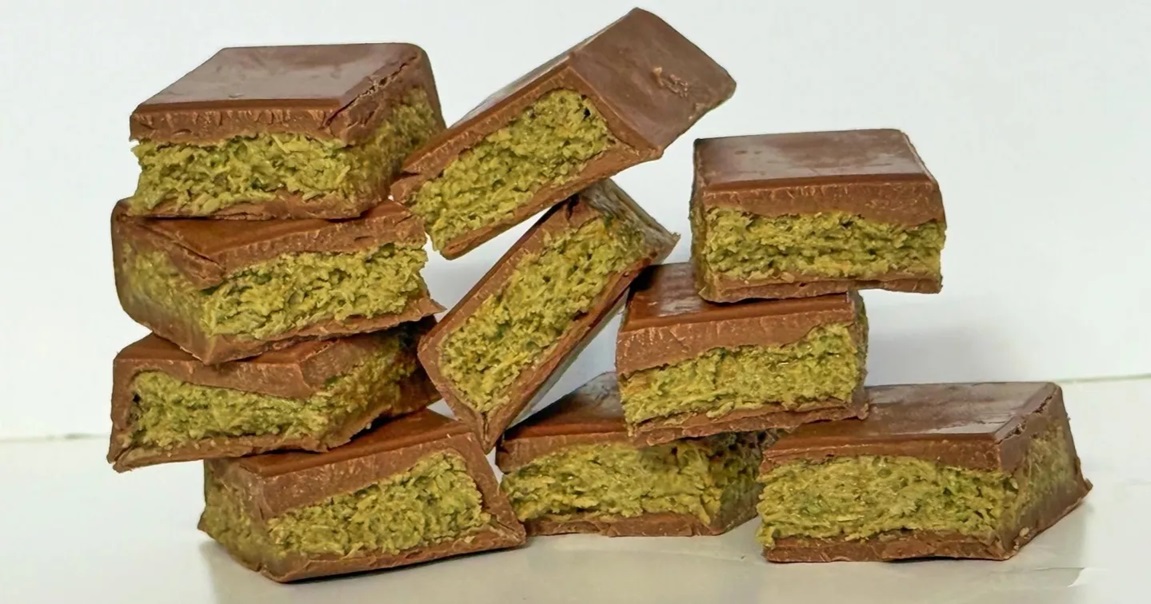Dubai chocolate craze expands beyond bars, inspiring global confections


While some food trends flare briefly and fade, Dubai chocolate appears to have taken root, spreading rapidly and evolving beyond its original bar format. The rich, indulgent flavors and thick texture that made Dubai chocolate bars a social media sensation are now appearing in a variety of confections worldwide.
The original Dubai chocolate bar, created by Fix Chocolatier in the UAE in 2021, gained viral popularity by 2023. Known for its thick milk chocolate shell encasing a creamy pistachio (and often tahini) filling with crispy, shredded, phyllo-like pastry called kadayif, the bar has become a template for new creations. Global brands and small bakers are now experimenting with Dubai chocolate in croissants, milkshakes, parfaits, and more, with fillings ranging from peanut butter and jelly to s’mores and matcha.
“This isn’t just a trend anymore — it’s a whole new category,” said Din Allall of The Nuts Factory, which operates about 150 U.S. stores featuring nuts, dried fruits, and candies.
The popularity of Dubai chocolate has even contributed to a pistachio shortage this year, according to Iranian producer Keinia, which attributed the scarcity to “the explosive surge in demand fueled by the viral ’Dubai chocolate’ TikTok trend, compounded by underlying supply constraints.”
Global interest in Dubai chocolate has surged. Google searches spiked early this year, peaking in March, and have remained high since. The Nuts Factory now offers 12 flavors of Dubai chocolate bars, as well as chocolate- and pistachio-coated Dubai dates, Dubai-coated roasted nuts, layered chocolate-pistachio strawberry parfaits, and a luxury Dubai Golden Chocolate bar infused with edible 24-karat gold priced at $79.99, while regular 6.5-ounce bars sell for $18.99.
Allall emphasized that the appeal lies not only in the flavors but also in the bar’s structure: “Huge, thick, with lots of filling.”
Retailers and restaurants embrace the craze
Major retailers and restaurants are capitalizing on the trend. Trader Joe’s sells a Dubai chocolate bar by Patislove, IHOP offered a limited-time Dubai pancake stack in August, and Baskin-Robbins features Dubai-inspired ice creams. Costco, Walmart, and QVC have introduced a variety of Dubai chocolate confections, including cakes. Swiss chocolate giant Lindt launched a limited Dubai chocolate bar in Europe last fall, drawing large crowds.
For many consumers, the texture is key. “The chocolate is soft and melty, the filling is creamy, and the kadayif adds a satisfying crunch,” said Erica Lefkowits, a Dublin shopper. Beyond taste, Dubai chocolate evokes luxury and exoticism through ingredients like pistachios, rose, saffron, and cardamom.
Although still niche in the U.S., Dubai chocolate sales are growing rapidly. Pistachio-filled chocolate retail sales totaled $822,900 in the year ending June 28, compared with $16.27 billion for all chocolates. Unit sales of pistachio-filled chocolates jumped 1,234% year-on-year, while overall chocolate sales dipped slightly.
Stew Leonard, Jr., CEO of New York-area grocery chain Stew Leonard’s, said, “I’ve never seen a single item sell like this in my 50 years of retailing.” The chain introduced the BeeMax Dubai chocolate bar in March, followed by its own house-branded version. They also launched a Dubai chocolate gift box for the holidays, including mini ice cream cones, pralines, and bars.
Other widely available U.S. brands offering Dubai chocolate include Moda, Magno, and Leonessa, with variations appearing as candies, coffee syrups, and more, signaling that Dubai chocolate is evolving into a global indulgence far beyond its original bar.
